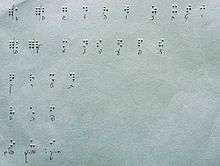Hebrew Braille
| Hebrew Braille ברייל עברי | |
|---|---|
 | |
| Type | |
| Languages | Hebrew |
Parent systems |
Braille
|
Print basis | Hebrew alphabet |
Hebrew Braille (Hebrew: ברייל עברי) is the braille alphabet for Hebrew. The International Hebrew Braille Code is widely used. It was devised in the 1930s and completed in 1944. It is based on international norms, with additional letters devised to accommodate differences between English Braille and the Hebrew alphabet.[1] Unlike Hebrew, but in keeping with other braille alphabets, Hebrew Braille is read from left to right instead of right to left.,[2] and unlike English Braille, it is a Abjad, all consonants.
History
Prior to the 1930s, there were several regional variations of Hebrew Braille, but no universal system.[1] In 1936, the Jewish Braille Institute of America assembled an international panel to attempt to produce a unified code. Among the greater challenges faced by the panel was the accommodation of the Hebrew vowel points. The panel completed its first iteration of the International Hebrew Braille Code in 1936,[1] the same year in which the first Hebrew Braille book was published with sponsorship from the Library of Congress: a volume of excerpts from the Talmud and other sources.[3] The code underwent further refinements for the better part of a decade until its completion in 1944.[1]
Basic alphabet
Because Hebrew Braille derives from English Braille, there is not a one-to-one match between Hebrew letters in print and in braille. Most obviously, four consonants with the dagesh point in print have distinct letters in braille, but three others require a dagesh prefix ⠘ in braille. The different placements of the dot on the print letter shin also correspond to two different letters in braille. On the other hand, the distinct final forms of some letters in print are not reflected in braille.
In the table below, the braille letters corresponding to basic letters in print are in the top row, while those derived by pointing in print, and which have a distinct pronunciation in Modern Hebrew, are in the second row.
| Basic | Braille | | | | | |
| | | | |
|
|---|---|---|---|---|---|---|---|---|---|---|---|---|
| א ’ | ב v | ג g | ד dh | ה h | ו w | ז z | ח ḥ | ט ṭ | י y | כ ך kh | ||
| Dagesh | Braille | | | | ||||||||
| בּ b bb | וּ û ww | כּ ךּ k kk | ||||||||||
| Basic | Braille | | | | |
| | | | |
| |
|---|---|---|---|---|---|---|---|---|---|---|---|---|
| ל l | מ ם m | נ ן n | ס s | ע ‘ | פ ף f | צ ץ ts | ק q | ר r | ש שׁ sh | ת th | ||
| Dagesh | Braille | | | | ||||||||
| פּ p pp | שׂ ś [4] | תּ t tt | ||||||||||
For other pointed print consonants, such as gimel with dagesh גּ, the braille prefix is used: ⠘⠛. Historically, this sequence has two values: a 'hard' gee [ɡ] (cf. plain gimel ⠛ [ɣ]), and a double/long gee [ɡː]. However, it is not distinct in Modern Hebrew. It is not clear if the prefix can be added to letters that have partners in the bottom row of the table above to distinguish, say, dagesh hazak kk from dagesh kal k, or ww from û.
When transcribing completely unpointed print texts, only the top row of braille letters is used.
Vowel pointing
Apart from those written with ו and י and thus obligatory in print, vowels are optional in braille just as they are in print. When they are written, braille vowels are full letters rather than diacritics.
| Braille | | | | |
| | | |
|---|---|---|---|---|---|---|---|---|
| א â | ◌ִ i | ◌ֵ e | ◌ֶ ẹ | ◌ַ a | ◌ָ ọ | ◌ֹ o | ◌ֻ u | |
| Braille | | | | | | | | |
| ◌ְ ə | יִ î | יֵ ê | ◌ֱ ĕ | ◌ֲ ă | ◌ֳ ŏ | וֹ ô | וּ û |
Print digraphs with אְ schwa (אֱ ĕ, אֲ ă, אֳ ŏ, bottom row), and the matres lectionis (וּ û, וֹ ô, יִ î) are derived in braille by modifying (lowering or reflecting) the base vowel. יֵ ê does not have a dedicated braille letter, and is written as the vowel ⠌ e plus ⠽ yod.
Numbers
| Braille | | | | | | | | | | |
|---|---|---|---|---|---|---|---|---|---|---|
| 1 | 2 | 3 | 4 | 5 | 6 | 7 | 8 | 9 | 0 |
Punctuation
The punctuation used with Hebrew Braille, according to Unesco (2013), is as follows:
, |
’ |
; |
: |
. |
! |
? “ |
” |
- |
/ |
* | |
( ... ) |
[ ... ] |
— |
... | ||||||||
References
- 1 2 3 4 Okin, Tessie (August 15, 1952). "I Shall Light a Candle". Canadian Jewish Chronicle. Retrieved October 19, 2010.
- ↑ Mackenzie, Clutha Nantes; Sir Clutha Nantes Mackenzie (1954). World Braille Usage: a survey of efforts towards uniformity of braille notation. UNESCO.
- ↑ Blumenthal, Walter Hart (1969). Bookmen's Bedlam: an Olio of Literary Oddities. Ayer Publishing. p. 175. ISBN 978-0-8369-1022-3.
- ↑ Placed here for convenience only; not actually a letter with dagesh
- UNESCO (2013) World Braille Usage, 3rd edition.